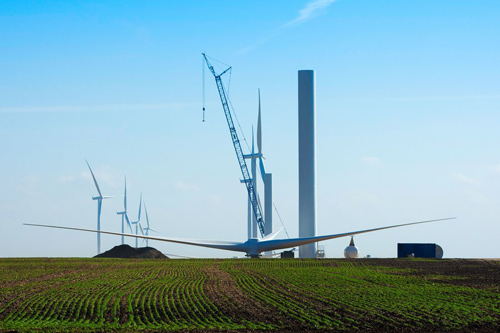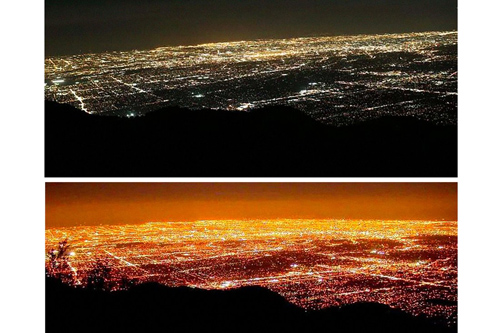|
俄克拉荷马州是化石燃料生产中心,在这里,牧场上散落着的是抽油机。但如果驱车一小时,前往俄克拉荷马城以西的格雷迪县,就会看到另一番景象。在明科市外围的小山顶上矗立着几十座80英尺(约24.4米)高的风力发电机,它们的扇叶不停地嗡嗡作响,时而还能听到奶牛的叫声和远处汽车驶过的声音。 这片金属“森林”是先驱者平原(Pioneer Plains)项目的一部分,为大约4.2万户家庭提供电力。这些风力发电机属于能源经济的高风险转型,赌的是可再生能源可以规模化,进而更为经济地代替那些引发气候变化的化石燃料。同时,风电场也是金融转型的象征——如果没有“绿色债券”这种10年前还不存在的投资工具,风电场也许根本就不会出现。 这种债券是美国银行发债部门的创意。在《财富》杂志今年的“改变世界”公司榜单上,这家资产规模870亿美元、员工20.9万人的巨无霸位居第三。这项工作是美银“环境业务倡议”的一部分,该倡议的规模为1250亿美元,它让总部设在夏洛特的美银成了“气候金融”大户。这项业务平淡无奇,但却很关键,它引导着投资者把资金投入低碳经济。2013年至今,由美银一手发明的绿色债券已在全球范围内融资4420亿美元,为借款人提供可再生能源创新费用。这些借款人中,有如加州Antioch市联合学区一样极小的借款人,也有像苹果公司一样庞大的借款人。 |
OKLAHOMA IS AN EPICENTER of fossil-fuel production, a state where oil-well pump jacks punctuate the pastures. But if you drive out to Grady County, an hour west of Oklahoma City, you’ll encounter a different mechanical landscape. There, atop the hills outside Minco, dozens of 80-foot-tall turbines churn, their blades generating a steady drone to accompany the occasional dairy-cow bleat and the buzz of distant cars. This metallic display is part of Pioneer Plains, a sprawling wind-power project that generates electricity for some 42,000 homes. The turbines are part of a highstakes transformation in the energy economy—a bet that renewable power can scale up as a cost-effective replacement for fuels that contribute to climate change. But the wind farm is also a symbol of financial transformation: It might never have sprouted if it weren’t for “green bonds”—an investment vehicle that didn’t exist a decade ago. Those bonds were the brainchild of dealmakers at Bank of America—the $87 billion, 209,000-employee giant that occupies the No. 3 spot on Fortune’s Change the World list this year. Their work is part of BofA’s $125 billion Environmental Business Initiative, a campaign that has established the Charlotte based bank as a powerhouse in “climate finance”—the unglamorous but essential business of steering investor capital into the low-carbon economy. Green bonds, which the bank all but invented, have raised $442 billion worldwide since 2013, helping borrowers both tiny (the Antioch, Calif., Unified School District) and enormous (trillion-dollar Apple) pay for renewable-energy innovations. |

|
大多数环保倡导者都认为没有私营行业的大力推动,就无法进行可再生能源革命。美银这样的大企业及其关系网和厚实的专业积累可以发挥决定性作用,把投资者和渴求资金的绿色项目联系在一起。追踪绿色能源投资的伦敦非营利组织Climate Bonds Initiative联合创始人兼首席执行官西恩·基德尼说:“打造历史上第一只商业绿色债券,向机构投资者推销——美银给这个市场带来了可信度。它给这个市场所带来的一切都非常宝贵。” 在这个时代,美国人可以通过当地电力公司购买太阳能电力,可以开着特斯拉轿车去办事,所以很难想象风电场或者太阳能发电项目还曾四处谋求资金。但在10年前,在横扫一切的金融危机中,情况正是如此。美银美林ESG债务资本市场董事总经理苏珊妮·布克塔解释说:“对风险的喜好真的不复存在了。人们认为大多数环境投资都有风险。” 当时,美银为错判风险付出了惨重代价。次贷坏账让它的资产负债状况陷入崩溃。投资者弃它而去,这使美银的市值蒸发了八成以上。该行最终接受了450亿美元的联邦援助资金。2009年12月上任的CEO布莱恩·莫伊尼罕跟高管团队进行了多次深刻反省。当时美银已偿还了援助资金,但就像莫伊尼罕回忆的那样,“我们为什么在这儿?如果我们不在了,谁会想念我们?”成了新的主题。 美银高管们重新思考了自己的使命,并且围绕着较保守的投资、美银的基本业务以及消费贷款压缩开支。在那个关键阶段,时任全球首席策略兼营销官的安妮·菲纽肯逐渐相信绿色投资可能是一项适合美银的业务。2007年,美银打算为此投入200亿美元,节能建筑等项目不大不小的成功让她和她的团队备受鼓舞。菲纽肯回忆道:“当时我们开展的这项业务让我们相信我们可以扩大规模,但我们必须证明这一点。” 2013年,菲纽肯得到了机会——在她敦促下,美银承诺为“低碳和可持续业务”再划拨1250亿美元,从而动员了一大批员工来谋划和推介新项目。承销商可以把点子卖给投资者;能源市场交易商知道哪里需要清洁电力;工程师了解风力发电机和太阳能面板的方方面面——美银在这三个专业领域都聘请了几十人。现已成为美银副董事长的菲纽肯成了联络人和倡导者,她把不同团队中的人召集在一起,并且帮他们获得高层投资。她说:“如果能让别人在他们的舒适区以外思考、工作并进行横向思维,就可以做成很多事。” 美银环境业务部门负责人娅历克斯·丽芙特曼对此表示同意:“我们把别人从他们知道怎么做的事务中拉出来,再把他们不知道怎么做的任务派给他们。然后他们想出主意的速度是我们预期的两倍。” |
Most environmental advocates agree that a renewable revolution can’t happen without a big private-sector push. And a behemoth like Bank of America—with its web of relationships and deep pool of expertise—can make a decisive impact in connecting investors with cash-hungry green projects. “Doing the first-ever commercial green bonds, appealing to institutional investors—BofA gave this market credibility,” says Sean Kidney, cofounder and CEO of the Climate Bonds Initiative (CBI), a London nonprofit that tracks green-energy investing. “They’ve been invaluable.” IN AN ERA WHEN AMERICANS can buy solar power through their local utilities and run errands in Teslas, it’s hard to imagine that wind farms or solar-panel arrays ever went begging for funds. But a decade ago, during the financial-crisis catastrophe, that’s exactly what was happening. “Risk appetite was really diminished,” explains Suzanne Buchta, managing director of ESG debt-capital markets at BofA Merrill Lynch. “And most environmental investing was seen as risky.” At the time, Bank of America was paying a heavy price for misjudging risk. Bad bets on subprime mortgages had demolished its balance sheet. Fleeing investors wiped out more than 80% of its market value, and the bank wound up taking $45 billion in federal bailout money. Brian Moynihan, who was tapped as CEO in December 2009, found himself holding multiple rounds of soul-searching with his C-suite team. The bailout had been repaid by then, but the new theme, as Moynihan recalls it, was “Why are we here? Who would miss us if we were gone?” Bank of America’s leaders rethought their mission, retrenching around more conservative investing and basic business and consumer lending. During that pivot, Anne Finucane, then the bank’s global chief strategy and marketing officer, became convinced that green investing could fit under that umbrella. The bank had made a $20 billion commitment to such projects in 2007, and modest successes with projects like energy-efficient buildings had encouraged her and her team. “We were convinced by the business that we were doing that this could work on a larger scale,” Finucane recalls, “but we had to prove it.” In 2013 she got her chance: At her urging, Bank of America committed to deploying another $125 billion for “low-carbon and sustainable business.” That mobilized an army of employees to dream up and pitch new projects. Underwriters who could sell ideas to investors; energy-market traders who knew where clean power was in demand; engineers who knew the ins and outs of turbines and solar panels—BofA employed dozens in each category. Finucane, who’s now the bank’s vice chairwoman, acted as connector and advocate, bringing people from disparate teams together and helping them get buy-in from the top. “If you ask people to think outside their comfort zone, to work and think horizontally, a lot can happen,” she says. “We were taking people off the things that they knew how to do, and putting them on things they didn’t know how to do,” agrees Alex Liftman, Bank of America’s environmental operations executive. “And they came up with ideas twice as fast as we expected. |

|
这些“异想天开”的人中就有债务专家布克塔。她是远足爱好者,热爱大自然。布克塔一直在思索怎样把投资者拉到绿色项目中。另外,她还知道债券相对股票有一些优势。一是稳定性——债券利息可以预期,而且只有在市场大崩溃时大多数债券才会像股票那样剧烈波动。这让债券非常吸引厌恶风险的养老基金经理、保险公司以及管理着全球多数资本的其他机构投资者。另一项优势是“有保护手段”——和股票不同,可以通过设计要求债券发行人只能将所得资金用于特定目的。 布克塔从2013年开始和另外几家大银行的同行合作,讨论出了一些“绿色债券整体原则”。他们一致认为,只有将所得资金投入显然有利于环境的项目,一只债券才称得上“绿色”。发行人必须明确告知投资人资金用途和项目进展,最好能由独立机构为债券的绿色程度颁发证书。布克塔说,“这个概念的精彩之处在于它是如此的简单而且如此的易于接触”,绿色债券可以在投资者的资金贡献和有助于气候的项目之间建立起清晰而且可以验证的联系。 为验证这个概念,美银当了一次“小白鼠”。2013年该行发行了历史上首只“基准规模”(或者说规模很大)的公司绿色债券。美银从投资者那里筹集到了5亿美元,然后将这笔钱投入了十几个项目。除了为先驱者平原项目购买风力发电机,这些资金还帮洛杉矶和奥克兰将大约17万盏路灯升级为LED节能灯,并让Antioch市在24所学校建立了太阳能发电站。 |
ONE SUCH BRAINSTORMER was Buchta, the debt specialist. An avid hiker and nature lover, she had been mulling how to draw investors into green projects, and she knew bonds had advantages over stocks. One was stability: Bond interest is predictable, and only during major meltdowns do most bonds become as volatile as stocks. That makes bonds hugely appealing to the risk-averse pension-fund managers, insurers, and other institutional investors that oversee the lion’s share of global capital. Another advantage was “ring fencing”: Unlike stocks, bonds could be structured to require issuers to use the proceeds only for specific purposes. Beginning in 2013, Buchta collaborated with her counterparts at several big banks, hashing out some broad “Green Bond Principles.” A bond, they agreed, could be called “green” only if its proceeds paid for projects with a clearly positive environmental impact. Issuers would have to be transparent with investors about where the money went and how the projects progressed, and, ideally, an independent party would certify the bond’s greenness. “The brilliant thing about the concept is that it’s so simple and so easily accessible,” says Buchta: A green bond would offer investors a clear, verifiable connection between their financial commitment and a project that helps the climate. To test the concept, Bank of America played guinea pig. In 2013 it issued the first-ever “benchmark-size” (that is, big) corporate green bond. BofA borrowed $500 million from investors, deploying the proceeds into a dozen different projects. The funds paid for turbines at Pioneer Plains; they also helped upgrade some 170,000 streetlights in Los Angeles and Oakland with energy-saving LED bulbs, and enabled Antioch to build solar arrays at 24 schools. |

|
如果只凭自己,这些可能有风险的小项目或许很难吸引到出资人,或者有可能使用高息贷款,甚至根本借不到钱。美银为它们降低了融资成本,将它们打包并用自己的信用评级为之提供支持(上述3年期债券的利率为1.35%,低息环境下这对投资者很有吸引力,和其他借款人相比也更有竞争力)。同时,尽管回报不是很高,这只债券仍获得了超额申购——在机构投资者寻找“更绿色”机会的情况下,需求超过了债券的发行规模。 市场证明了概念,接着是其他借款人争相涌入。马萨诸塞州政府于2013年发行了第一只贴“绿色”标签的市政债券。大型公用事业企业Southern Co.为太阳能和风能项目筹集了逾10亿美元。2016和2017年,苹果公司发行了25亿美元绿色债券,资金用途是为该公司更多的设施提供可再生电力。这些交易都由美银担任主承销商,也就是吸引投资者的撮合者。截至目前,美银已经承销了270亿美元的绿色债券,超过了其他任何一家美国银行。同时,一个更大的市场已经成型。Climate Bonds Initiative的数据显示,2017年1月1日以来绿色债券的发行金额已达2540亿美元,超过了此前四年的总和。 以创造性方式为绿色事业谋得资金让银行业人士感到骄傲。在先驱者平原(归NextEra Energy所有,该公司在“改变世界”榜上排名第21位)等二十几个能源项目中,美银用发债所得资金进行“税收公平”投资,也就是向开发商支付预付款,从而换取他们的绿色能源退税权。这样做让开发商获得了建设和维修资金;美银则可通过它拿到的退税权来降低自身税务开支。美银的另一个项目Catalytic Finance Initiative专门用于巧妙地解决气候金融难题。去年,Catalytic Finance Initiative团队帮Vivint Solar将来自3万个居民太阳能账户的现金流整合为一只规模2.03亿美元的债券,然后将它出售给了投资者。 |
On their own, those small, potentially risky projects would have struggled to attract lenders and would have borrowed at high rates if they could borrow at all. By bundling them and backing them with its own credit rating, Bank of America brought the cost down. (The three-year bond paid 1.35%—attractive to investors in a low-rate climate, but a bargain for borrowers.) And although the payout wasn’t huge, the bond issue was oversubscribed: With institutional investors seeking more green opportunities, there was more demand than there were bonds to sell. The market had its proof of concept—and other borrowers rushed in. The Commonwealth of Massachusetts issued the first municipal bond to be labeled “green,” in 2013. The giant utility Southern Co. raised more than $1 billion for solar and wind projects. Apple issued $2.5 billion in green bonds in 2016 and 2017, financing an effort to run more of its facilities on renewable power. BofA was the lead underwriter on each of those deals, playing matchmaker to attract investors. To date, it has underwritten $27 billion worth of green bonds, more than any U.S. bank. At the same time, a broader market has taken off. Since Jan. 1, 2017, there have been $254 billion in green-bond issuances, according to CBI—more than in the previous four years combined. Bank staffers take pride in the creative ways they’ve deployed capital for green causes. At Pioneer Plains (which is owned by NextEra Energy, No. 21 on the Change the World list) and two dozen other energy projects, BofA has used bond proceeds to make “tax equity” investments, paying developers upfront in return for the right to claim their green-energy tax credits. The deals give the developers funding for construction and repairs; the bank uses the credits to cut its own tax bill. Another BofA project, the Catalytic Finance Initiative, specializes in crafty climate-finance puzzle solving. Last year the CFI team helped Vivint Solar package the cash flows from 30,000 of its residential solar accounts into a $203 million bond and sell the debt to investors. |

|
美银并未具体说明环境业务创造了多少收入,但承销费、贷款利息和咨询费已经给它带来了利润。2007年以来美银承诺将为绿色业务投入1450亿美元,到目前为止已经划拨资金逾960亿美元。该行自身的情况最近也有好转。在过去三年中,美银股价的上涨速度一直是标普500指数的两倍,该公司利润也增长了20%。 美银设计的债券帮Vivint Solar筹集了2亿多美元资金。今年4月,四位经济学家发表的初步论文让绿色债券粉丝们有理由乐观起来。这些经济学家发现,“绿色”市政债券的收益率比非绿色债券低6个基点,而对更进一步、获得了绿色认证的债券来说,这个差距会增加1-2倍。买家抬高价格时债券收益率就会下降,因此较低的收益率表明对绿色债券的需求超过了普通债券。就典型的市政债券而言,这有可能节省下数百万美元利息。参与撰写该论文的纽约大学斯特恩商学院金融学教授杰弗里·沃格勒说,和这些益处相比,“认证一只绿色债券的成本不高”,而且借款方和投资人都会“蒙上一层环保光辉”。 亟待回答的问题是这样的光辉能变得多大、多亮?而且速度如何?电动汽车生产、能源存储、“智能电网”建设——这些都是可以取得长足进步的领域,但私营行业必须要动员资金来支持它们,而且是以每年万亿美元的规模,而非数十亿美元。美银CEO莫伊尼罕指出:“公共资金不够。但必须以私人资金习惯的方式来接触它。”如果较为稳定和熟悉的绿色债券能把更多大资金吸引入局,美银将功不可没。(财富中文网) 原文最初刊登在2018年9月1日出版的《财富》杂志上,题为《吹动绿色能源的风》。 译者:Charlie 审校:夏林
|
BofA doesn’t break out how much revenue its environmental business has generated, but underwriting fees, loan interest, and advisory fees have made the enterprise profitable. To date, the bank has deployed more than $96 billion of the $145 billion it has committed to green business since 2007. Its own fortunes have improved lately too. Over the past three years, its stock has risen twice as fast as the S&P 500, and profits are up 20%. A bond deal structured by Bank of America helped Vivint Solar raise more than $200 million.In April, four economists released a working paper that gave green-bond fans reason for optimism. They found that municipal bonds labeled “green” paid six basis points (0.06%) less in yield than nongreen bonds—and that the effect doubled or tripled for bonds that took the extra step of being certified green. Bond yields fall when buyers drive up prices, so the lower yields suggest that demand for green bonds is stronger than the norm. On a typical muni bond, that could result in millions of dollars in savings on interest. Compared with those benefits, “the cost of certifying a green bond is modest,” says coauthor Jeffrey Wurgler, a professor of finance at the NYU Stern School of Business, while borrower and investor alike “get a green glow.” The urgent question is how much bigger and brighter that glow can get, and how quickly. Electric-vehicle production, energy storage, the building of “smart grids”—all are areas where great strides could be made, but only if the private sector can mobilize the money to fund them, at the rate of trillions per year rather than billions. “Public capital is not enough,” notes BofA’s Moynihan. “But private capital has to be accessed in a way that it’s used to being accessed.” If green bonds, with their relative stability and familiarity, lure more big money into the game, Bank of America will have done a lot to pave the way for it. A version of this article appears in the September 1, 2018 issue of Fortune with the headline “The Wind At Green Energy’s Back.” |






